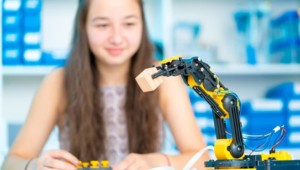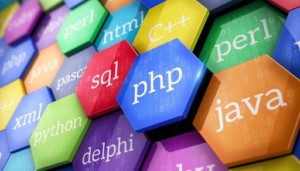Preparing for the Future: Building Interest in Computer Science

Over the past couple of weeks, there have been discussions focused on the need for computer science curriculum in schools. During recent Twitter chats and in webinars and panel discussions, educators have shared concerns about bridging the K-12 computer science gaps. There is a growing need for students to develop skills in coding and in STEM-related fields however, there are either real or perceived barriers to providing these opportunities for students.
Possibilities include, lack of resources, or inadequate staffing, perhaps not enough room in student schedules, or a perceived lack of knowledge by educators when it comes to bringing computer science into their classes. For some, it can also be a lack of confidence in knowing where to begin or a hesitancy to not start if we don’t feel confident enough, which was the case for me.
Fortunately, there are many options available for educators to bring CS into their classrooms. The benefits include promoting student agency and self-paced learning, the development of essential SEL skills, and promoting student curiosity and innovation in learning. What I believe is important is that all teachers create opportunities for students to learn about computer science, how to code, and apply coding skills to all grade levels and content areas.
Last year, I referred to the World Economic Forum, for the job outlook for 2022. The report shared the importance for students to develop skills such as collaboration, communication, critical thinking, creativity, and problem-solving. The need for STEM skills will continue to increase as we see new and emerging technologies develop. A prior projection was that 3.5 million STEM jobs will need to be filled by 2025.
In addition to STEM skills, students specifically need exposure to computer science. I recently took one of the newer Microsoft Educator courses on computer science and it also shared some interesting statistics. It stated there will be 49 million more digital jobs created by 2025 in fields including AI, cybersecurity, and data analytics, which will require students to have computer science skills. Families are also in support of bringing more computer science into our schools, as a Gallup poll from September 2020, reported that 69% of parents and guardians in the United States expect schools to integrate computer science into the curriculum.
As educators, we need to have resources available that enable us to build our own skills but that also provide students with personalized learning opportunities to explore computer science and find something that meets their specific interests and needs. The goal is to better inform students and hopefully to spark curiosity for learning and lead our students to become creators and innovators.
Here are six resources to explore that will give students a chance to see how computer science impacts our world and build their skills in a variety of focus areas.
Amazon Future Engineers: An interesting opportunity for students to learn how computer science, engineering, algorithms, and machine learning are used in Amazon’s fulfillment centers. There are options to take a tour focusing on computer science, or to interact with an Amazon tour guide or to sign up for a one-hour learning experience. There are many resources including slides and activities aligned to the computer science standard available in the Teacher Toolkit. This provides a real-world learning opportunity for students. Teachers can register for tours that will continue through July 1st. This is a good option for in-person or remote learning.
AI World School: Offers a variety of courses and resources for learning about STEM and coding. In addition to three flagship AI courses, there are several micro-courses available divided into the three age groups and with topics including creating with Scratch, building an Android or iOS app, and more advanced options such as JavaScript and Python coding for older students.
CoderZ: A cloud-based STEM learning opportunity, where students can code 3D robots. There are different courses available through CoderZ including CoderZ Adventure for ages 6 through 10, Robotics 101, a self-paced program for ages 11 through 14, Summer Robotics 1 or 2 for ages 11 to 14, and Python gym for students ages 15 and older. It has 3D simulations of robots, students can write and test their own code, and teachers have access to self-paced curriculum and teacher guides. Students receive immediate results of their work which is great for in-person or remote learning. CoderZ integrates with Clever, ClassLink, and Google Classroom.
Grasshopper: For teachers or adult learners looking to build their own skills, Grasshopper is a coding app for beginners. The name is in recognition of Grace Hopper, a pioneer in computer science. The Grasshopper curriculum is divided into topics including fundamentals, array methods, animations, web page design, and more. There are many types of coding activities and lessons available through Grasshopper that are available for free on Android and iOS as well as for desktop use.
Kubo coding: A good program for starting with elementary students specifically grades K through 5. Students can build their coding skills through a tag tile programming language which is a puzzle-like coding concept. Kubo Play is a new simulation tool that works well for a blended learning experience by giving students hands-on coding activities and 300 tasks that cover ISTE standards for coding.
Mblock: Easy to get started with coding by choosing to code with blocks or code with Python. They have featured coding products and additional resources such as online coding training for Scratch, robotics programming, and Python. There are also sample projects where students can view the code and then start creating their own projects.
These are just a few of the resources to explore that will be helpful for learning regardless of whether in-person or virtual. The end of the school year is always a good opportunity to try some new ideas that will help to keep students engaged, and hopefully develop an interest in computer science. These can even be fun options to explore with family and build skills together. Check out the Family code night!
For more, see:
- Smart Review: Blackbird Education Platform
- Getting Started with Coding: 18 Tools for Early Learners
- Empowering Families to Teach Coding at Home
- Where the STEM Workforce is Headed and What Society Must Do to Get There
Stay in-the-know with innovations in learning by signing up for the weekly Smart Update.





0 Comments
Leave a Comment
Your email address will not be published. All fields are required.